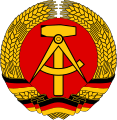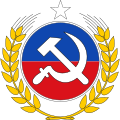Hammer and sickle


The hammer and sickle (☭) is a part of communist symbolism and its usage indicates an association with Communism[citation needed], a Communist party, or a Communist state. It features a hammer and a sickle overlapping each other. The two tools are symbols of the industrial proletariat and the peasantry; placing them together symbolises the unity between industrial and agricultural workers. This emblem was conceived during the Bolshevik Revolution.
It is best known from having been incorporated into the red flag of the Soviet Union, along with the Red Star. It has also been used in other flags and emblems.
Soviet and Russian usage
The hammer and sickle was originally a hammer on a plough, with the same meaning (unity of peasants and workers) as the better known hammer and sickle. The hammer and sickle, though in use since 1917/18, was not the official symbol until 1922, before which the original hammer and plough insignia was used by the Red Army and the Red Guard on uniforms, medals, caps, etc.
Later, the symbol was featured on the flag of the Soviet Union, adopted in 1923 and finalized in the 1924 Soviet Constitution, and flags of the republics of the Soviet Union after 1924. Before this, the flags of Soviet republics tended to be a plain red field, with the golden text of the name of the respective republic superimposed on it, as stipulated in Article 90 of the 1918 Soviet Constitution.
- The Coat of Arms of the Soviet Union and the Coats of Arms of the Soviet Republics showed the hammer and sickle, which also appeared on the Red Star badge on the uniform cap of the Red Army uniform and in many other places.
- Serp i Mólot (transliteration of Russian: Серп и молот, "sickle and hammer") is the name of the Moscow Metallurgical Plant.
- Serp i Molot is also the name of a stop on the electric railway line from Kurski railway station in Moscow to Gorki, featured in Venedikt Erofeev's novel, Moscow-Petushki.
Some anthropologists have argued that the symbol, like others used in the Soviet Union, was actually a Russian Orthodox symbol that was used by the Communist Party to fill the religious needs that Communism was replacing as a new state "religion." The symbol can be seen as a permutation of the Russian Orthodox two-barred cross.[1]
Current usage
Two federal subjects of the post-Soviet Russian Federation use the hammer and sickle in their symbols: The Vladimir Oblast has them on its flag and the Bryansk Oblast has them on its coat of arms, which is also the central element of its flag.
The former Soviet (now Russian) national airline, Aeroflot, continues to use the hammer and sickle in its symbol.
The separatist government of Transnistria uses (with minor modifications) the flag and the emblem of the former Moldavian SSR, which include the hammer and sickle. The flag can also be used without the hammer and sickle in some circumstances, for example on Transnistrian-issued license plates.
The Communist Party of China uses it as the party symbol. It is also used by Communist Parties in most countries.
The Maoist terrorist group, Shining Path in Peru uses it as part of its symbol.
A hammer and a sickle are both prominently included in the Austrian coat of arms, but they are not superimposed over each other and are not intended to represent communism.
Variations of the symbol

Many symbols having similar structures and messages to the original have been designed. For example, the Angolan flag shows a segment of a cog, crossed by a machete, and crowned with a socialist star. In the logo of the Communist Party of the United States, a circle is formed by a half cog and a semicircular sickle-blade. A hammer is laid directly over the sickle's handle with the hammer's head at the logo's center. The logo of the Communist Party of Turkey consists of a half cog wheel crossed by a hammer, with a star on the top.
Tools represented in other designs include: the brush, sickle, and hammer of the Workers' Party of Korea; the spade, flaming torch, and hoe used prior to 1984 by the British Labour Party (which is and was a socialist and not a communist party); the monkey wrench and tomahawk of the Earth First! movement; the pickaxe and rifle used in communist Albania; and the hammer and compasses of the emblem of the East German flag. The Far Eastern Republic of Russia used an anchor crossed over a spade or pickaxe, symbolising the union of the fishermen and miners. The Fourth International, founded by Trotsky, uses a hammer and sickle symbol on which the number '4' is superimposed. The Trotskyist League for the Fifth International merges a hammer with the number '5', using the number's lower arch to form the sickle.
The Communist Party of Britain uses the hammer and dove symbol. Designed in 1988 by Mikhal Boncza, it is intended to highlight the party's connection to the peace movement. It is usually used in conjunction with the hammer and sickle, and appears on all of the CPB's publications. Some members of the CPB prefer one symbol over the other, although the party's 1994 congress reaffirmed the hammer and dove's position as the official emblem of the Party. Similarly, the Communist Party of Israel uses a dove over the hammer and sickle as its symbol. The flag of the Communist Party of Guadeloupe uses a sickle, turned to look like a majuscule 'G', to represent Guadeloupe.[2]
With differing intent, the eagle on the Austrian flag holds a golden hammer in its left talon, and a golden sickle in its right talon. The tools were not meant to be references to communism (indeed, the eagle also wears a golden crown) but, rather, were meant to represent the industrial and agricultural laborers, united with the former aristocracy, in one republican democracy.
The National Bolshevik Party, a Third Position grouping which organises in Russia and other former republics of the USSR, uses a flag with a strong visual resemblance to the red, white and black flag of the German Nazi Party, except that a hammer and sickle replaces the swastika.
The flag of Burma features a bushel of rice superimposed on a cogwheel.
Unicode
In Unicode, the "hammer and sickle" symbol is U+262D. (☭)
Legal status
In some countries that were formerly allied with the Soviet Union, the Hammer and Sickle and the Red Star is viewed negatively. Government authorities of Republic of Hungary,[3] Latvia[citation needed], Lithuania[4] and Poland[5] have banned the symbol along with other communist symbols. Persons found guilty of possession, production or distribution of communist symbols may in Poland be sentenced to two years in prison[citation needed]. A similar law was considered in Republic of Estonia, but eventually failed in a parliamentary committee.
In 2003, Hungarian politician Attila Vajnai was arrested, handcuffed and fined for wearing a red star on his lapel during a demonstration. He appealed his sentence to the European Court of Human Rights, which decided last year that the ban was a violation of the freedom of expression, calling the Hungarian ban "indiscriminate" and "too broad." [6]
Such laws in these countries have aroused controversy. Polish parliamentarian told Spiegel Online, "What does it mean, 'symbol'? Does that mean when government officials go to China and make pictures under the banner of the Communist Party they are breaking the law?"[7]
Gallery
-
Flag of USSR from 12 November 1923 - August 19, 1955.
-
Flag of USSR from 15 August 1980 - 25 December 1991.
-
The hammer and sickle as it appears on the Communist Party of China flag.
-
Flag of the Lebanese Communist Party.
-
Sickle and Axe flag of the Chinese Soviet Republic.
-
Flag of the Romanian Communist Party.
-
Flag of Bryansk Oblast.
-
Flag of Angola as of 1975
-
The emblem of the GDR.
-
Flag of the DPRK's Workers' Party of Korea.
-
1976 Albanian banknote with a pickaxe and a Mosin-Nagant rifle.
-
Emblem of the Fourth International.
-
The hammer and dove, symbol of the Communist Party of Britain.
-
Logo of Aeroflot.
-
Symbol of the Communist Party of Chile
-
The Coat of Arms of Austria where the hammer represents industry and the sickle agriculture.
-
The Flag of the Communist Party of the Philippines.
-
The Flag of the Communist Party of India (Marxist) and Communist Party of India.
-
The Flag of the Shining Path.
-
The Flag of the Revolutionary People's Liberation Party–Front.
-
The logo of the Italian Socialist Party.
-
The logo of the Democratic Party of the Left
-
Logo of the League for the Fifth International.
-
Logo of Communist Party USA.
See also
References
- ^ David Lempert, Daily Life in a Crumbling Empire: The Absorption of Russia into the World Economy, Columbia University Press/ Eastern European Monographs, 1996.
- ^ Flags of the World
- ^ Hungarian Criminal Code 269/B.§ (1993.)
- ^ BBC NEWS | Europe | Lithuanian ban on Soviet symbols
- ^ http://www.foxnews.com/story/0,2933,577305,00.html
- ^ http://www.spiegel.de/international/europe/0,1518,663154,00.html
- ^ http://www.spiegel.de/international/europe/0,1518,663154,00.html
External links
- Flag of North Korea's Korean Workers' Party (which uses the hammer, pen and hoe)
- Old symbol of the British Labour Party (spade, torch and quill).
- Hammer and sickle
- Communism
- National symbols of Armenia
- National symbols of Azerbaijan
- National symbols of Belarus
- National symbols of Georgia (country)
- National symbols of Kazakhstan
- National symbols of Kyrgyzstan
- National symbols of Laos
- National symbols of Moldova
- National symbols of Russia
- National symbols of the Soviet Union
- National symbols of Tajikistan
- National symbols of Turkmenistan
- National symbols of Ukraine
- National symbols of Uzbekistan
- Soviet phraseology
- Political symbols

















